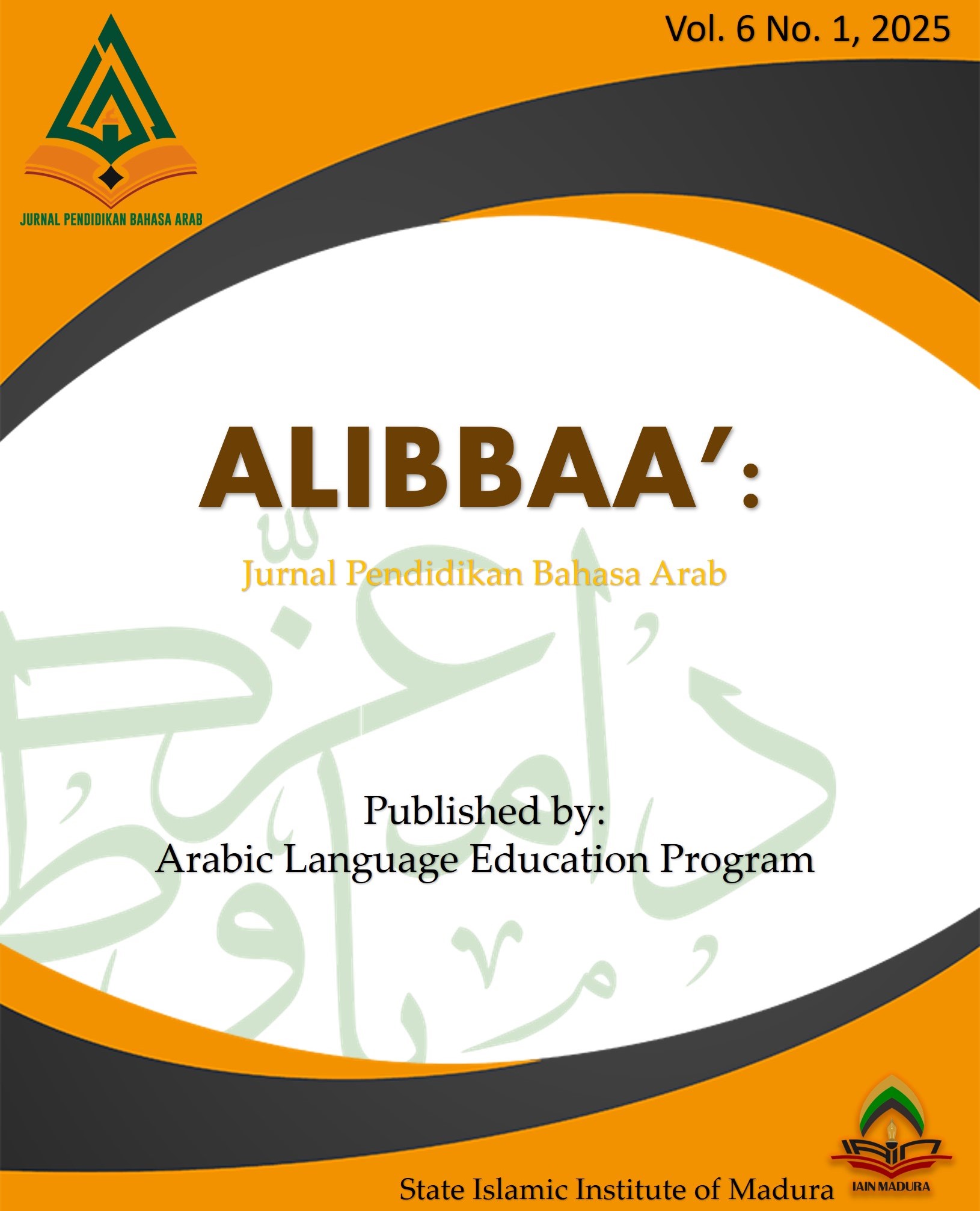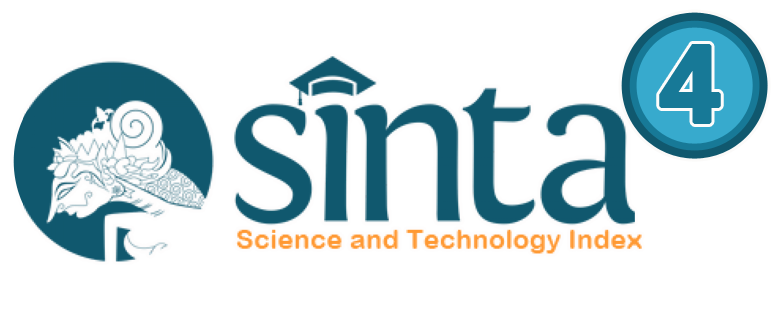Curiosity-Driven Learning in Arabic: A Case Study on the 'Inquiring Minds Want to Know' Approach
 Abstract views: 51
,
Abstract views: 51
,
 pdf downloads: 61
pdf downloads: 61
Abstract
This study aims to analyze the implementation of the "Inquiring Minds Want to Know" learning model in Arabic language instruction at MTsN 3 Tulungagung. The model was chosen to address the gap between students' desire to learn and their ability to cultivate curiosity. This research employed a phenomenological qualitative approach, utilizing interviews, observations, and documentation for data collection. The findings reveal that the implementation of the "Inquiring Minds Want to Know" learning model in Arabic language instruction follows four main stages: (1) formulating questions that stimulate students' interest in learning and discussion, (2) providing opportunities for students to make predictions or guesses, (3) recording all student predictions without immediately providing answers to maintain curiosity, and (4) using questions as a bridge to connect learning materials and delivering appropriate answers throughout the learning process. This learning model has proven effective in enhancing students' active participation and critical thinking skills in the context of Arabic language learning.
Downloads
References
Al-Omari, Fatmah. “Teaching Arabic Language for Non-Native Speakers in the Light of Modern Linguistics.” Dirasat: Human and Social Sciences 43, no. 3 (2016): 2529–36. https://doi.org/10.35516/0103-043-003-018.
Arifin, Zamri, Nur Khadijah Abu Bakar, Zaharom Ridzwan, and Ezad Azraai Jamsari. “Language Learning Strategies of Non-Muslim Students Applied to Arabic Language Course Inside and Outside the Classroom.” Ijaz Arabi Journal of Arabic Learning 4, no. 1 (2020): 1–11. https://doi.org/10.18860/ijazarabi.v4i1.9995.
Azli, Noor, Mohamed Masrop, Hafawati Ishak, Ghazali Zainuddin, and Siti Rosilawati Ramlan. “Digital Games Based Language Learning for Arabic Literacy Remedial.” Creative Education 10, no. 2 (2019): 3213–22. https://doi.org/10.4236/ce.2019.1012245.
Bogdan, R., & Biklen, S. K. Qualitative Research for Education. Boston: Allyn & Bacon, 1997.
Dale Schunk. Learning Theories an Educational Perspective. VI. Yogyakarta: Pustaka Pelajar, 2018.
Dooly, Melinda, and Ron Darvin. “Intercultural Communicative Competence in the Digital Age: Critical Digital Literacy and Inquiry-based Pedagogy.” Language and Intercultural Communication 22, no. 3 (May 4, 2022): 354–366. https://doi.org/10.1080/14708477.2022.2063304.
Dörnyei, Z. (2020). Innovations and Challenges in Language Learning Motivation (1st ed.). Routledge. https://doi.org/10.4324/9780429485893
Fahrurrozi, Aziz. “Pembelajaran Bahasa Arab : Problematika Dan Solusinya.” ARABIYAT: Jurnal Pendidikan Bahasa Arab Dan Kebahasaaraban 1, no. 2 (2014). https://doi.org/10.15408/a.v1i2.1137.
Ferguson-Patrick, Kate. “Cooperative Learning in Swedish Classrooms: Engagement and Relationships as a Focus for Culturally Diverse Students.” Education Sciences 10, no. 11 (October 31, 2020): 312. https://doi.org/10.3390/educsci10110312.
Gillies, Robyn M. “Using Cooperative Learning to Enhance Students’ Learning and Engagement during Inquiry-Based Science.” Education Sciences. Multidisciplinary Digital Publishing Institute (MDPI), December 1, 2023. https://doi.org/10.3390/educsci13121242.
Hamed Sedghi, Soheyla Mohseny nejad, Seyyed Adnan Eshkevari, Pouran Rezaei choshali, and Hossein Talebzadeh. “Identifying the Speaking Proficiency Level of Arabic Learners in Accordance with the International Guidelines of ACTFL for Assessing Proficiency in Foreign Languages.” Research in Arabic Language 12, no. 25 (January 2020): 1–22.
Hamzah. “Kontruktivisme Dan Implikasinya Dalam Pembelajaran Bahasa Arab.” Jurnal Nasional 3, no. 1 (2018): 119.
Hattie, John, Jill Crivelli, Kristin Van Gompel, Patti West-Smith, and Kathryn Wike. “Feedback That Leads to Improvement in Student Essays: Testing the Hypothesis That ‘Where to Next’ Feedback Is Most Powerful.” Frontiers in Education 6 (May 28, 2021). https://doi.org/10.3389/feduc.2021.645758.
Hattie, J. Visible Learning: A Synthesis of over 800 Meta-Analyses Relating to Achievement. London: Routledge, 2009.
Hilmi, Danial, and Nur Ila Ifawati. “Using the Blended Learning As an Alternative Model of Arabic Language Learning in the Pandemic Era.” Arabi : Journal of Arabic Studies 5, no. 2 (2020): 117. https://doi.org/10.24865/ajas.v5i2.294.
Husna, Ilya, Zikrawahyuni Maiza, Suci Ramadhanti Febriani, Rahmat Satria Dinata, and Fauzul Fil Amri. “Digital Game-Based Learning: Exploring the Use of Mobile Legends in Arabic Language Skills.” Al-Ta’rib : Jurnal Ilmiah Program Studi Pendidikan Bahasa Arab IAIN Palangka Raya 12, no. 1 (June 2, 2024): 1–16. https://doi.org/10.23971/altarib.v12i1.8015.
Kashdan, Todd B., Melissa C. Stiksma, David D. Disabato, Patrick E. McKnight, John Bekier, Joel Kaji, and Rachel Lazarus. “The Five-Dimensional Curiosity Scale: Capturing the Bandwidth of Curiosity and Identifying Four Unique Subgroups of Curious People.” Journal of Research in Personality 73 (April 1, 2018): 130–49. https://doi.org/10.1016/j.jrp.2017.11.011.
Khadijah, Khadijah. “Improving Students’ Interest in IPS Lessons by Inquiring Minds Want to Know Learning Model.” CAHAYA PENDIDIKAN 9, no. 2 (January 10, 2024): 106–15. https://doi.org/10.33373/chypend.v9i2.4650.
Khalil, Mohammed K., and Ihsan A. Elkhider. “Applying Learning Theories and Instructional Design Models for Effective Instruction.” AJP Advances in Physiology Education 40, no. 2 (April 12, 2016): 147–156. https://pubmed.ncbi.nlm.nih.gov/27068989/.
Khuluq, Muchsinul, and Nurul Imamah. “Enhancing Arabic Reading Skills: A Prezi Program-Based Learning Material Development for Integrated Islamic Elementary Schools in Indonesia.” Journal of Arabic Language Learning and Teaching (JALLT) 2, no. 1 (March 1, 2024): 33–58. https://doi.org/10.23971/jallt.v2i1.157.
Kosim, Nanang, Ade Arip Ardiansyah, Hilda Saripatul Hikmah, and Yusuf Ali Shaleh Atha. “The Use of The Task-Base Language Teaching (TBLT) Method to Improve Learning Outcomes of Arabic Language Skills.” Alibbaa’: Jurnal Pendidikan Bahasa Arab 5, no. 2 (July 31, 2024): 144–65. https://doi.org/10.19105/ajpba.v5i2.14804.
Lailatus Sangadah, Ika. “IMPLEMENTASI STRATEGI PEMBELAJARAN INQUIRING MINDS WANT TO KNOW GUNA PENINGKATKAN AKTIVITAS BELAJAR SISWA KELAS X-7 SMA NEGERI 5 SURAKARTA IMPLEMENTATION OF INQUIRING MINDS WANT TO KNOW LEARNING STRATEGY TO INCREASE STUDENTS LEARNING ACTIVITIES IN CLASS X-7 SMA NEGERI 5 SURAKARTA.” Vol. 3, 2011.
Mahdi, Rijal, and Ahmad Asri Lubis. “Perspectives on the Arabic Language from University Student: Between Reality and Hope.” Izdihar : Journal of Arabic Language Teaching, Linguistics, and Literature 3, no. 1 (2020): 45–58. https://doi.org/10.22219/jiz.v3i1.11757.
Mardiah, Nur Hizbullah & Zaqiatul. “Masalah Pengajaran Bahasa Arab Di Madrasah Aliyah Di Jakarta.” Jurnal Al-Azhar Indonesia 2, no. 3 (2014): 21.
Miles, M.B.;, and A.M. Huberman. Qualitative Data Analysis. 3rd ed. USA: Sage Publication, 2014.
Munayf Hudhair al-Dhawiy. Al-Nadzhoriyah al-Binaiyyah Wa Tathbiyquha Fi Tadris al- Lughah al-’Arabiyah. Rafhaa: Maktabah al-Malik Fahdh al-Wathaniyah, 2013.
Nofya, Mona, and Atmazaki Atmazaki. “Investigating the Effect of Inquiring Mind Want to Know Assissted by Audiovisual Media and Learning Motivation Students’ Writing Skills.” Journal of Languages and Language Teaching 12, no. 1 (January 9, 2024): 379. https://doi.org/10.33394/jollt.v12i1.9653.
Nurul Hadi, Nuri Alvina, and None Khaled Radhouani, “Ta’zîzu Dâfi’iyyati Thullâbi Riyâdh al-Athfâl Li Tathwîri Mahârât al-Lughah Al-’Arabiyyah al-Syafawiyyah Min Khilâli Barâmiji al-Ta’lîm al-Mukatstsaf,” Alibbaa Jurnal Pendidikan Bahasa Arab 5, no. 2 (July 31, 2024): 189–214, https://doi.org/10.19105/ajpba.v5i2.12195.
PAPI, MOSTAFA, ANGEL RIOS, HUNTER PELT, and ESRA OZDEMIR. “Feedback‐Seeking Behavior in Language Learning: Basic Components and Motivational Antecedents.” The Modern Language Journal 103, no. 1 (March 21, 2019): 205–26. https://doi.org/10.1111/modl.12538.
Ritonga, Mahyudin, Asrina, Rizka Widayanti, Fitri Alrasi, Julhadi, and Syaflin Halim. “Analysis of Arabic Language Learning at Higher Education Institutions with Multi-Religion Students.” Universal Journal of Educational Research 8, no. 9 (2020): 4333–39. https://doi.org/10.13189/ujer.2020.080960.
Sahkholid Nasution. Tahtwîr Namūzaj Ta’lîm Al-Nahwi Fî Dhaui Nazhriyah Ta’lîm al-Binâiyah. Malang: UIN Malang, 2016.
Syafi’i, Isof. “Model Pembelajaran Bahasa Arab Berbasis Konstruktivisme Di Perguruan Tinggi Islam.” Bandung, 2008.
Tadesse, Tefera, Robyn M. Gillies, and Catherine Manathunga. “The Effects of Informal Cooperative Learning Pedagogy on Teaching Effectiveness, Task Orientation, and Learning Satisfaction in Undergraduate Classrooms in Ethiopia.” Higher Education Research & Development 40, no. 3 (May 22, 2020): 627–645. https://doi.org/10.1080/07294360.2020.1765320.
Taylor, S. J, Bogdan, R. Introduction to Qualitative Research Methods. New York: Oxford University Press, 1992.
Trentman, Emma. “Imagined Communities and Language Learning during Study Abroad: Arabic Learners in Egypt.” Foreign Language Annals 46, no. 4 (2013): 545–64. https://doi.org/10.1111/flan.12054.
Uril Bahruddina, Muhammad Fadli Ramadhana, Halomoan Halomoanb, Diaya Uddeen Deab Mahmoud Alzitawic, M Abdul Hamida. “The Quality Improvement of The Interaction Indicators of The Arabic Language Learning in Higher Education.” Izdihar : Journal of Arabic Language Teaching, Linguistics, and Literature 4, no. 1 (2021): 59–70. https://doi.org/10.22219/jiz.v4i1.15919.
Wargadinata, Wildana, Iffat Maimunah, Saidna Zulfiqar, Bin Tahir, and M Chairul Basrun. “Arabic Creative and Participative Learning : In Search of a New Way of Language Learning by ‘ El Jidal Reborn ’ Youth Community in Malang Universitas Islam Negeri Maulana Malik Ibrahim Malang , Indonesia.” International Journal of Advanced Science and Technology 29, no. 8 (2020): 4319–32. Wildana Wargadinata et al., “Arabic Creative and Participative Learning : In Search of a New Way of Language Learning by ‘ El Jidal Reborn ’ Youth Community in Malang Universitas Islam Negeri Maulana Malik Ibrahim Malang , Indonesia,”International Journal of Advanced Science and Technology 29, no. 8 (2020): 4319–32.
Wekke, Ismail Suardi, and Maimun Aqsha Lubis. “A Multicultural Approach in Arabic Language Teaching: Creating Equality at Indonesian Pesantren Classroom Life.” Sosiohumanika 1, no. 2 (2016): 295–310. https://doi.org/10.2121/sosiohumanika.v1i2.337.
Yan, Zi. Student Self-Assessment as a Process for Learning, 2022. https://doi.org/10.4324/9781003162605
Zaccone, M.C. and Pedrini, M. (2019), "The effects of intrinsic and extrinsic motivation on students learning effectiveness. Exploring the moderating role of gender", International Journal of Educational Management, Vol. 33 No. 6, pp. 1381-1394. https://doi.org/10.1108/IJEM-03-2019-0099
Zahrani, Budor Saeed Al, and Tariq Elyas. “The Implementation of Critical Thinking in a Saudi EFL Context: Challenges and Opportunities.” IJELTAL (Indonesian Journal of English Language Teaching and Applied Linguistics) 1, no. 2 (May 19, 2017): 133. http://dx.doi.org/10.21093/ijeltal.v1i2.21.
Zurqoni, Heri Retnawati, Syarifatur Rahmatullah, Hasan Djidu, and Ezi Apino. “Has Arabic Language Learning Been Successfully Implemented?” International Journal of Instruction 13, no. 4 (2020): 715–30. https://doi.org/10.29333/iji.2020.13444a.
Authors who publish with this journal agree to the following terms:
a. Authors retain copyright and grant the journal right of first publication with the work simultaneously licensed under a Creative Commons Attribution License that allows others to share the work with an acknowledgement of the work's authorship and initial publication in this journal.
b. Authors are able to enter into separate, additional contractual arrangements for the non-exclusive distribution of the journal's published version of the work (e.g., post it to an institutional repository or publish it in a book), with an acknowledgement of its initial publication in this journal.
c. Authors are permitted and encouraged to post their work online (e.g., in institutional repositories or on their website) prior to and during the submission process, as it can lead to productive exchanges, as well as earlier and greater citation of published work (See The Effect of Open Access).
Alibbaa': Jurnal Pendidikan Bahasa Arab have CC-BY-SA or an equivalent license as the optimal license for the publication, distribution, use, and reuse of scholarly work.
In developing strategy and setting priorities, Alibbaa': Jurnal Pendidikan Bahasa Arab recognize that free access is better than priced access, libre access is better than free access, and libre under CC-BY-SA or the equivalent is better than libre under more restrictive open licenses. We should achieve what we can when we can. We should not delay achieving free in order to achieve libre, and we should not stop with free when we can achieve libre.

Alibbaa': Jurnal Pendidikan Bahasa Arab is licensed under a Creative Commons Attribution 4.0 International License
You are free to:
- Share — copy and redistribute the material in any medium or format
- Adapt — remix, transform, and build upon the material for any purpose, even commercially.
- The licensor cannot revoke these freedoms as long as you follow the license terms.











